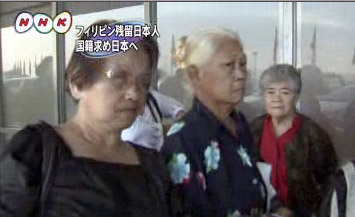By TESSA JAMANDRE
SIXTY-NINE-YEAR-OLD Kumiko Nakasone last saw her Japanese father at the close of World War II. The family was separated when her father and brother were repatriated to Japan shortly after, leaving her and two other siblings behind.
Nakasone’s father is now dead, but Nakasone has always yearned to see her brother and other relatives in Okinawa, her father’s hometown.
The reunion may happen soon. On Tuesday, Nakasone, who has been living in Davao, was among the 16 war-displaced Japanese descendants in their 70s and 80s who left on a Japan Airlines flight for Japan, their fathers’ birthplace.
They are Nikkei-jins or Japanese emigrants and their descendants who have established families and communities in other countries.
 With either a son or daughter in tow (Nakasone was accompanied by her daughter Edna), the 16 elderly Nikkei-jins left Manila with two sets of travel documents, one issued by the Japanese Embassy and the other by the Department of Foreign Affairs, that indicate their nationality as stateless—for now. They will ask the Japanese courts to recognize them as Japanese citizens.
With either a son or daughter in tow (Nakasone was accompanied by her daughter Edna), the 16 elderly Nikkei-jins left Manila with two sets of travel documents, one issued by the Japanese Embassy and the other by the Department of Foreign Affairs, that indicate their nationality as stateless—for now. They will ask the Japanese courts to recognize them as Japanese citizens.
All except one are second-generation Nikkei-jins. Catalina dela Cruz, 83, the wife of the late Katsuo Takamine, is first-generation.
Nakasone’s batch could be the last to visit Japan under a Nippon Foundation project that helps Filipinos of Japanese descent restore their family registries and be recognized. The foundation’s Shuseki project, which began in August 2006 and is intended to restore the family registers of 500 people over a three-year period, is ending.
Shuseki is a new koseki or family registry created upon a decision of family court in Japan if a Japanese national cannot locate his or her father’s koseki.
The Philippine Nikkei-jin Legal Support Center (PNLSC) estimates that there are about 2,000 descendants of originally pre-war Japanese emigrants to the country who were drafted into the Japanese military when it occupied the Philippines during World War II.
Many of them died during the war, but those who survived were repatriated to Japan. The wives and children they left behind lived secluded in the mountainous regions of the Philippines. Most of them lost documents proving their ties to Japan.
About 800 of these descendants, mostly children or second-generation Nikkei-jins, are either dead or cannot be located, while 300 others are alive but cannot be traced.
A total of 105 have petitioned Japan’s family court for recognition as Japanese citizens. Only 28 of these petitions have been approved.
Among the 16 who left Tuesday were Leonald Yoshida, 80, and Tomasa Oshima, 70, whose petitions were earlier denied by the family court due to lack of evidence to prove their fathers were Japanese. Their birth documents were destroyed during the war.
Recently, however, Yoshida managed to retrieve his birth record at the National Archives that his father himself had registered. Not Oshima, though. All she has are vivid memories of her father who lived with them until his death in the hands of guerrillas. Both are appealing their cases before Japan’s High Court.
Nakasone, meanwhile, is set to convince the Japanese family court that she is indeed the daughter of the late Yama Nakasone from Okinawa. Her case has been pending since 2006. “In my father’s memory and his name that I carry, I couldn’t be anybody else but a Japanese. I have always felt so since I was a child,” Nakasone said when asked what she was going to tell the court.
For the Ataniya siblings Seiichi, 68 and Yoshiko, 67, the prospects for a reunion with their Japanese kin are certain. On Friday, they and five other Nikkei-jins are flying from Tokyo to Okinawa where they will address a forum at Ryuku University and meet their relatives.
Like most of the Nikkei-jins, the Ataniya siblings feared persecution and discrimination after the war and hid their identities. They took on Filipino names, Rodolfo and Trinidad, complicating their cases before the Japanese family court.
The PNLSC, established in 2003 as part of the centennial anniversary of Japanese migration to the Philippines, helped trace the family roots of the Ataniyas and other descendants.
The center’s counterpart in Japan has aided orphans of Japanese descent left behind in China and Sakhalin, successfully backing 1,250 Japanese orphans in China in their bid to obtain Japanese citizenship. It hopes that the Japanese and Philippine governments can work out a system similar to China’s such as creating a master list of the Japanese descendants that they will mutually recognize.
Yoshiko has kept a picture of her father and, coupled with the recognition of her father’s relatives waiting to meet her for the first time in Okinawa, is almost certain that her petition will be approved by the family court in Japan.
“Even if my father isn’t around anymore, I’m happy nevertheless for this chance to be able to see his country of birth. It’s as if he’s also alive,” Yoshiko said.
The Japanese citizenship the Nikkei-jins will obtain will extend to their own descendants up to the fourth generation. They can acquire legal status if they choose to live and work in Japan. At present, Japan’s labor market is restricted to their citizens except for trade agreements that allow the entry of healthcare workers.